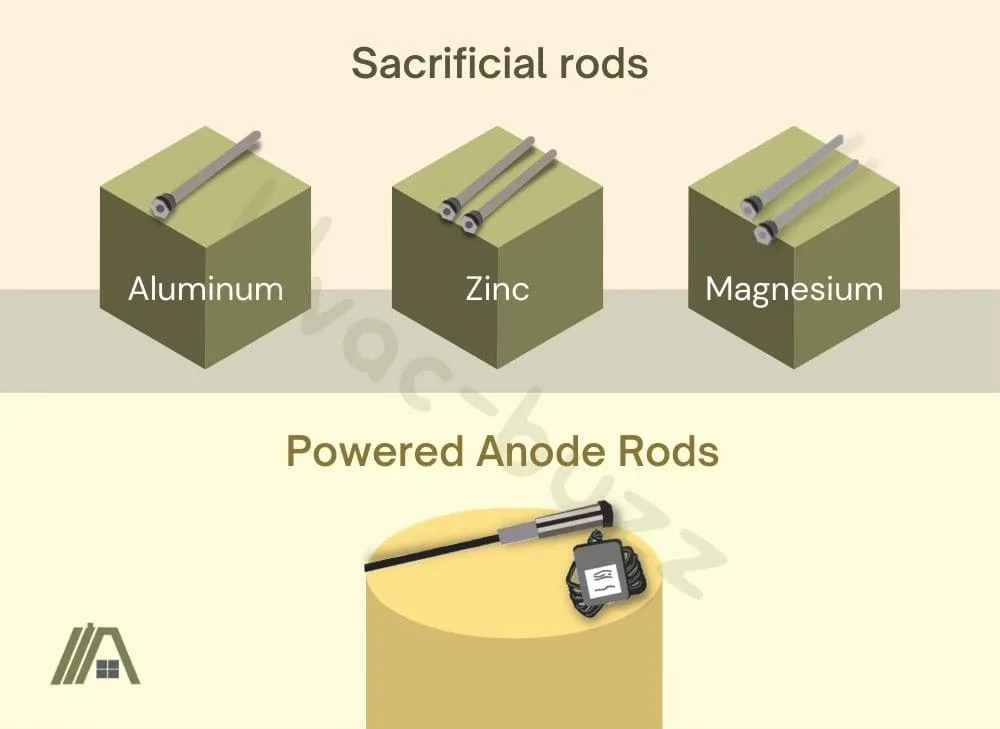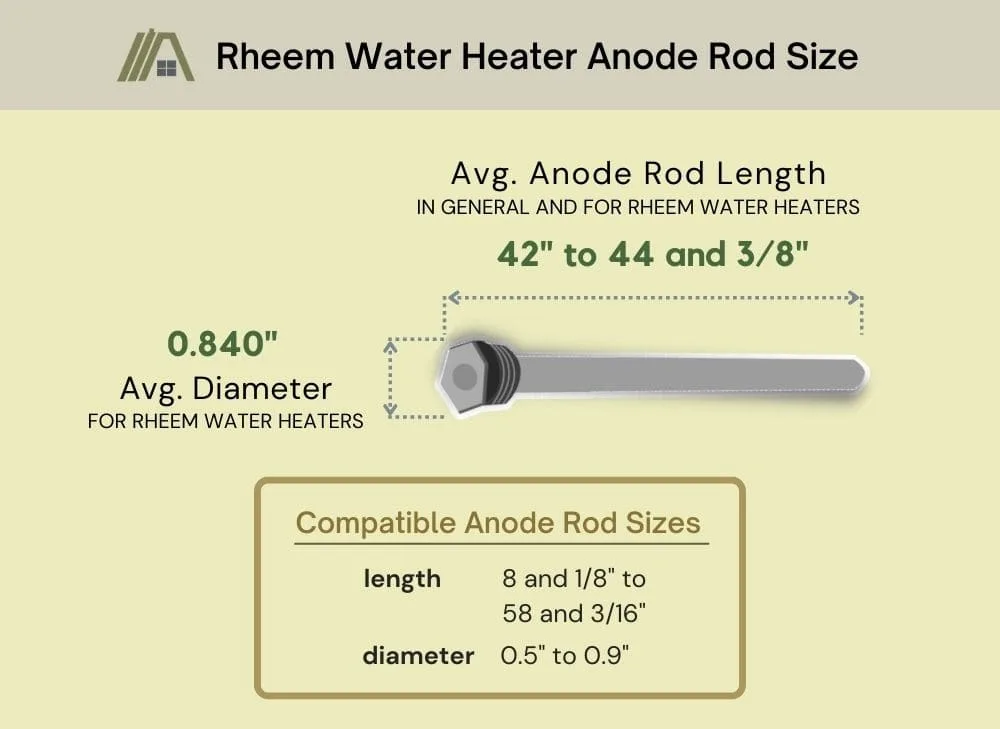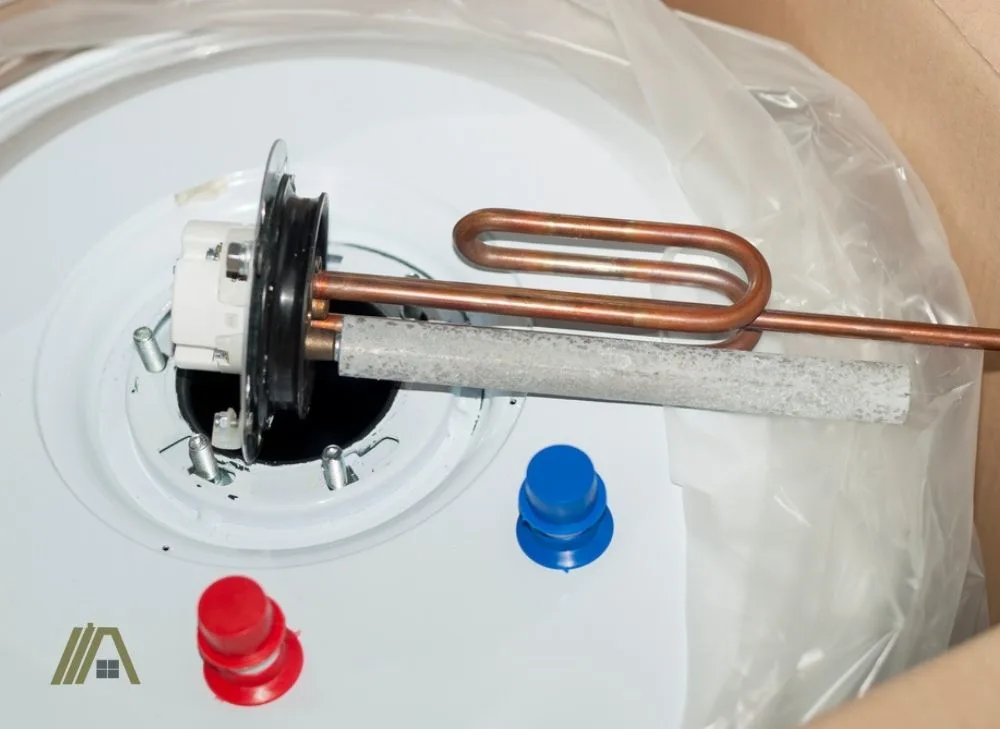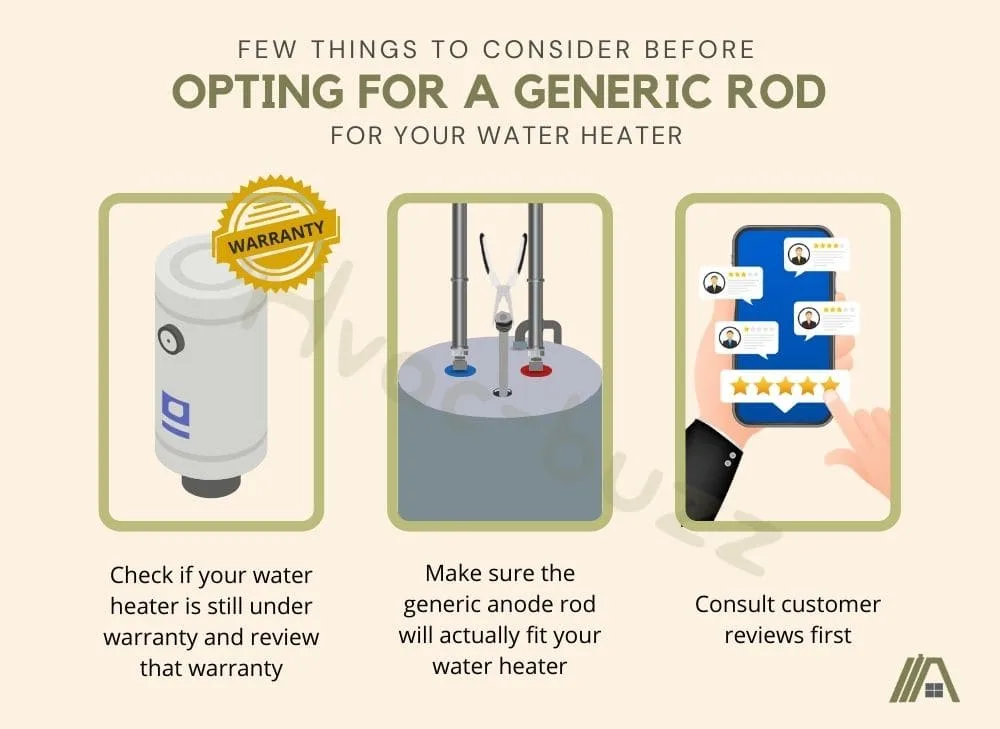Understanding the importance of anode rods is the first step to taking care of your water heater. The next step would be fully understanding the sizes, types, and locations of anode rods for your specific water heater.
If you own a Rheem water heater, here is everything you need to know about your anode rod.

Rheem water heaters are designed to work with all anode rod types. They conform to the average sizes of anode rods available (length and diameter). Thus, generic rods can be used circumspectly. Replacement is relatively easy. Rods are inexpensive and available online and in hardware stores.
Not all Rheem Water Heaters Have Anode Rods
To anode rod, or not to anode rod? That is the question. It’s a good question, and I am here to help you out. Anode rods are closely associated with water heaters, and with good reason. They make a massive difference to the life expectancy of your water heater.

Rheem water heaters have an anode rod to protect the metal storage tank unless they are plastic or tankless models. Aluminum and magnesium rods are popular, suitable choices for Rheem heaters, but some better fit specific water conditions. It’s relatively easy to find, detach, and replace the rod.
Rheem Tank-Type Heaters Have Anode Rods
Water heaters with metal storage tanks require anode rods as protection from the corrosive substances in the water. Anode rods are designed to interact with these substances preferentially and corrode in the place of the water heater storage tank.
Without the rod, that corrosion would be directed at the storage tank and will eventually cause it to leak or burst—an inconvenience and expense we all want to avoid.
Standard Rheem tank-type water heaters will need an anode rod; however, there is a model that is the exception. This is the Marathon model, which is made with a plastic tank and titanium elements.
Titanium is highly unreactive, so it’s unaffected by the corrosive elements in the water. Furthermore, corrosion is the result of these elements reacting with the metal of a tank. Without the metal tank, you don’t get that same corrosion process, so the plastic tank jacket is also resistant to corrosion.
This means that no anode rod is needed in the Rheem Marathon water heater as there is nothing the rod needs to protect.
What Type of Anode Rod Does Rheem Use?
Rheem water heaters do not use one type of anode rod. Instead, as is the case with most water heater manufacturers, they design their products to be used with whatever anode rod best suits the quality of water supplied to your home.
The main factors of water quality that come into play with anode rods are:
- Mineral content, i.e., hardness.
- Excess ions that result from artificial softening.
- Sulfate-reducing bacteria.
There are two main types of anode rods: powered and sacrificial. There are three main kinds of sacrificial rods: aluminum, magnesium, and zinc alloy (alloyed with aluminum). Rheem water heaters readily use any of these rods.

The reason why there is so much freedom in the type of rods you can use is that all anode rods are metal sticks that screw into the water heater.
As long as the hole into which they screw is the standard size (with Rheem water heaters, they always are), then virtually any rod you buy will be able to be used in your water heater.
Because choosing the best anode rod for your Rheem water heater comes down to the quality of your water, you can have a look at these articles to help you choose the best one:
- Aluminum vs Magnesium sacrificial anode rods.
- Powered anodes vs Aluminum anodes.
- Powered anodes vs Magnesium anodes.
- Anode rods for smelly water (zinc alloys).
- Anode rods for artificially softened water (magnesium or powered).
Rheem Water Heater Anode Rod Size
Rheem water heaters are compatible with a large range of anode rod sizes.
The range of lengths includes anode rods that are 8 and 1/8″ long to anode rods that are 58 and 3/16″ long.
Although there is a large range in lengths, the average length, in general and for Rheem water heaters in particular, is 42″ to 44 and 3/8″.
The diameters that are compatible with the Rheem water heater include 0.5″ to 0.9″.
As far as the average diameter of an anode rod in a Rheem water heater, the most common diameter seems to be the 0.840″ one.

Where Is the Anode Rod in a Rheem Water Heater?
For most Rheem water heaters, the anode rod will be located at the top of the tank. It is likely that they will be placed in the center of the top of the tank under a hexagonal head with a plastic cover.
For more specific information on the location of the anode rod in your Rheem water heater, it is wise to consult your specific water heater’s user manual.
Some water heaters come with two anode rod insert points. However, unless you are utilizing a professional-grade model, it is more likely that your Rheem water heater will have only one place for an anode rod rather than two.
The second anode rod port, if it is included in your Rheem water heater, is likely to be near the original anode rod port with the same hexagonal head with a plastic cover.
Electric and gas water heaters are powered differently, so they are set up differently. However, as far as the placement of anode rods goes, electric and gas Rheem water heaters will likely only differ by a few inches along the top of the tank.
Replacing a Rheem Water Heater Anode Rod
Cost of the Replacement
Depending on the type of anode rod you are utilizing, the cost of replacing the anode rod in a Rheem water heater will vary.
- For an aluminum anode rod, the prices range from $25 and $45.
- For a magnesium anode rod, the prices range from $32 and $75.
- If you are using a powered anode rod, the prices are usually between $150 and $190.
The prices will rise even more if you were to hire someone to replace your anode rod for you. Most professionals will charge between $250 and $300 to replace an anode rod.

Should You Buy a Generic Rod?
While Rheem-brand anode rods are more likely to fit well and work well, they are more expensive than generic anode rods, which will still fit and function in your water heater.
To save money but ensure the longevity of your water heater, there are a few things to consider before just opting for a generic rod.
Firstly, check if your water heater is still under warranty and if the warranty is dependent on the use of Rheem-brand anode rods. You don’t want your heating element breaking down only to find out Rheem is unable to honor the warranty because you used a generic rod.
Note: The rod itself will never have a warranty if it is a sacrificial rod.
Secondly, it is also important to make sure the generic anode rod will actually fit your water heater. As mentioned, Rheem heaters are designed to match the average, but generic rods may be slightly off-size depending on their quality.
Thirdly, as with all purchases you are apprehensive about, it is wise to consult customer reviews. The lower cost of a generic anode rod may not be worth it if it works terribly.

Where to Get the New Rods
After you have considered whether you would like to purchase a Rheem or name-brand anode rod or a generic anode rod, there are plenty of options of where you can buy them.
Most hardware stores carry a variety of anode rods. You can simply pop in and look through their range. Alternatively, you can call ahead or check the website if you are looking for a particular model. Some hardware stores facilitate online purchases and delivery.
Other online stores, like Amazon, can also be utilized. Amazon sells some Rheem-brand rods and some generic rods that are specifically compatible with Rheem water heaters.
- For best results, use only Rheem replacement parts for repairing your Rheem Water Heater
- Anodic Material: Magnesium, Total Length (in.): 44-3/8, Rod Diameter (in.): 0.700, Hex Head Size (in.): 1-1/16
- Thread Size - NPT (in.): 3/4, Resistored: Yes
- Kits which contain this part: 45W363
Last update on 2024-03-27 / Affiliate links / Images from Amazon Product Advertising API
Rheem itself has an online store with various products as well as various fitments of anode rods.
Understanding Part Numbers
If you want to replace your anode rod with another one exactly the same then you need to know the part number. Look for this in your water heater’s user manual or give the manufacturer a call (if you know the rod is the original one that came with the heater).
Part numbers are likely to be composed of around eight to ten digits. They will contain mostly numbers but also letters to associate them with a specific water heater.
The part number allows you to locate a part on a given diagram of your appliance and also allows you to look up this specific part and model online if you need a replacement.
It is likely that your anode rod will have a specific part number that goes with it. If you would like to buy the exact same anode rod, the part number will allow you to buy it again without having to make sure the dimensions and such are correct.
How to Replace the Anode Rod
Before tackling the project of replacing your anode rod, it is important that you have all of the tools needed.
| Item Name | Link to Amazon |
| CRAFTSMAN Deep Socket, 1-1/16-Inch | view |
| CRAFTSMAN Ratchet Wrench | view |
| NEIKO 00206A 1/2-Inch-Drive Premium Breaker Bar, 24-Inch Length | view |
| Klein Tools Flathead Screwdriver | view |
| Teflon Tape | view |
| Gilmour Pro Commercial Hose | view |
| CRAFTSMAN 12-Inch Hacksaw (only necessary if the rod must be shortened) | view |
Once you are sure that you have all of the tools required, you may begin the process.
- The first and most important step is to turn off the power supply at the circuit breaker if it is an electric heater or to turn off the gas supply if it is a gas water heater.
- Next, you must close the shut-off valve at the main water supply or the cold water inlet. Then, a hot water faucet must be turned on somewhere in the house in order to relieve the pressure inside the water heater tank.
- The water must then be drained from the tank with the hose. Ensure that the water is not near any people or pets since the water can cause burns.
- Locate the anode rod at the top of the tank. Remove the plastic cap and if the anode rod isn’t visible, remove the insulation with your flathead screwdriver.
- The anode rod can then be removed with your ratchet wrench. To break the seal on the anode rod, it is likely that you’ll need the breaker bar for enough leverage.
- Now the anode rod can be removed.
- Next, wrap Teflon tape around the threads of the new anode rod and reinstall.
- You can now fill your tank and check that there are no leaks around the new anode rod.
These are fairly basic steps. For a more comprehensive guide, the video below describes the process in detail.
The most important thing to remember when reinstalling an anode rod yourself is that the power or gas must be shut off and the pressure should be removed from the tank for safety reasons.
It is also important to be sure that the drained water and the old anode rod are handled with care since it is likely that they’ll still be hot.
Sources
https://www.corroprotec.com/blog/ufaqs/where-is-anode-rod-on-rheem-water-heater/
https://www.alsplumbing.com/water-heater-rheem-professional-water-heater/


